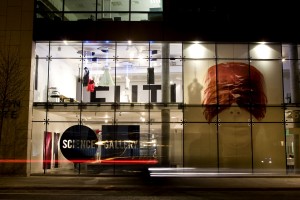
If you think science is boring you must have never visited the Science Gallery on Pearse Street. It is a public science center, ‘where art and science collide’. Exhibitions are represented by diverse fields of study from ìgeneral nerdinessî to fashion, mixed in with other subjects like chemistry, physics, astronomy, earth sciences, biology, mechanics, neurology, and maths.
Science Gallery is part of Trinity College. Opened in 2008 it is housed in the Naughton Institute. To date over a million people have visited the Gallery. Admission is free to all exhibitions and while a not-for-profit charity, it is all-for-education, as the shows include exhibits, experiments and events. The purpose of the Science Gallery is to introduce 15 – 25 year olds to all the joys of science. The intention is to demonstrate to young people that science links to so much in life.
The current show Oscillator surveys rhythms, cycles, waves, vibrations and feedback loops. Shaun O’Boyle, from the Gallery, explains oscillation in layman’s terms as “the patterns we find around us, such as the flow of traffic on Pearse St at different times of the day and how it increases during rush hour’. At the exhibition these loops and cycles are explained in various ways, including blood flowing around a pig’s body via its heart or the synchronicity of a pendulum. Risk Lab is showing from May until June and explores why we think the improbable is probable. Illusion starts in July and explores why we see what we do. In October the exhibition Living Machines questions how close we are to creating synthetic life.
To help visitors to the exhibition, there are mediators, who explain in detail about each installation. The mediators are usually students in the college. This opens up the whole experience, as their conversation and chat attaches more significance to what you are seeing, touching, hearing or smelling.
This flourishing science gallery is the first of its kind. It is to be expanded to other cities around the world, such as London, Moscow and Singapore due to its accomplishments in science education and promotion here in Dublin via the galleryís exhibitions and advice on school subject choices, college courses and decisions relating to future careers. Dr. Michael John Gorman, director of the Science Gallery clarifies, ‘We’re planning eight Science Gallery hubs around the world by 2020. In each city, we tap into a vibrant local creative community of researchers, designers, artists and entrepreneurs to engage and inspire the next generation of innovators’.
A visit to the Science Gallery should also include a trip to the shop, full of curiosities and the Flux CafÈ, where you can sit and observe the traffic flow on Pearse St for yourself and chat about what you saw at the exhibition. So head on down to explore all kinds of everything, as this gallery is a world leader in fun.
Science Gallery: http://sciencegallery.com/
Facebook: Science Gallery
Oscillator Exhibition: http://sciencegallery.com/oscillator or http://sciencegallery.com/podcast
by Tracy O’Brien



